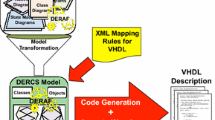Abstract
Design of Embedded Systems is becoming more and more complex in terms of verify that requirements are fulfilled at different design levels. This requires the simulation of the system and the checking of its timing and functional properties. model-driven design and UML give a reasonable solution to cope with such complexity since they have mechanisms to model and verify embedded systems. This paper presents a methodology which starts from UML/MARTE sequence diagrams with timing constraints and the automatic generation of executable SystemC/TLM and VHDL code with checkers from such diagrams. The simulation of the generated model allows to verify the specified sequence of exchanged information between components while checkers allow to verify that properties and timing constraints are met. Three case studies are used to show the validity of the approach and a less than linear increase of execution time overhead due to time observation and assertion checkers.















Similar content being viewed by others
References
Accellera Standard OVL V2 Library Reference Manual (2011) OVL 2.6. http://www.accellera.org
Alagar VS, Periyasamy K (2011) Extended Finite State Machine. In: Gries D, Schneider FB (eds) Specification of Software Systems. Texts in Computer Science, Springer London, pp 105–128. http://link.springer.com/book/10.1007%2F978-0-85729-277-3
Atego (2013) Artisan Studio. http://www.atego.com
Bombieri N, Di Guglielmo G, Ferrari M, Fummi F, Pravadelli G, Stefanni F, Venturelli A (2010) HIFSuite: Tools for HDL Code Conversion and Manipulation. EURASIP Journal on Embedded Systems 1:436,328
EDALAB (2012) HIFSuite: Tools and APIs for HDL Code Conversion and Manipulation- version 2012.12. http://www.hifsuite.com
Balarin F et al (1997) Hardware–Software Co-design of embedded systems: the polis approach. Kluwer Academic Press, Norwell
Habibi A, Tahar S (2006) Design and verification of SystemC Transaction-Level Models. Very Large Scale Integr (VLSI) Syst, IEEE Trans 14(1):57–68
Heng D, Ping G, Xiao-mei Y, Lin-li Z (2010) A research of object constraint language used in PIM accurate modeling. In: International conference on information management and engineering (ICIME), pp 629–632
IBM (2012) IBM Rational. http://www-01.ibm.com/software/rational/
Manual R (2000) IEEE Standard VHDL Language. IEEE Std 1076–2000, pp i–290. doi:10.1109/IEEESTD.2000.92297
Martin G, Muller W (2005) UML for SoC design. Springer, New York
Martin G, Smith G (2009) High-level synthesis: past, present, and future. Des Test Comput, IEEE 26(4):18–25
McUmber W, Cheng B (1999) UML-based analysis of embedded systems using a mapping to VHDL. In: International symposium on high-assurance systems engineering, 1999, pp. 56–63
Moreira T, Wehrmeister M, Pereira C, Petin JF, Levrat E (2010) Automatic code generation for embedded systems: from UML specifications to VHDL code. In: International conference on industrial informatics (INDIN), 2010, pp 1085–1090
Mueller W, Villar E, Carballeda, M (2010) The SATURN approach to SysML-Based HW/SW Codesign. In: Computer society annual symposium on VLSI (ISVLSI), 2010, pp 506–511
Nguyen K, Sun Z, Thiagarajan P, Wong WF (2004) Model-driven SoC design via executable UML to SystemC. In: Real-Time systems symposium, pp 459–468
Object Management Group (2009) OMG Unified Modeling LanguageTM (OMG UML), superstructure(version 2.2). In: OMG document number: formal/2009-02-02. http://www.omgmarte.org
Object Management Group (2011) A UML Profile for MARTE (version 1.1). In: OMG document number: formal/2011-06-02. http://www.omgmarte.org
Object Management Group (2013) Acceleo. http://www.eclipse.org/acceleo/
Riccobene E, Scandurra P, Rosti A, Bocchio S (2005) A SoC design methodology involving a UML 2.0 profile for SystemC. In: Design, Automation and test in Europe, pp 704–709 Vol. 2
Sébastien Gérard et al. (2012) Papyrus UML, http://www.papyrusuml.org
Technical report (2005) Survey of system design trends. Technical report, Electronics Weekly & Celoxica
Transaction Level Modeling Working Group (2006) OSCI TLM 2.0. http://www.systemc.org
Vanderperren Y, Mueller W, Dehaene W (2008) UML for electronic systems design: a comprehensive overview, vol 12. Springer, Berlin
Xi C, Hua LJ, ZuCheng Z, YaoHui S (2005) Modeling SystemC design in UML and automatic code generation. In: Design automation conference, 2005. Proceedings of the ASP-DAC 2005. Asia and South Pacific, vol 2, pp 932–935
Yu J, Li T, Tan Q (2006) The use of UML sequence diagram for System-on-Chip system level transaction-based functional verification. in: the sixth world congress on intelligent control and automation, 2006, vol 2, pp 6173–6177
Author information
Authors and Affiliations
Corresponding author
Rights and permissions
About this article
Cite this article
Ebeid, E., Fummi, F. & Quaglia, D. HDL code generation from UML/MARTE sequence diagrams for verification and synthesis. Des Autom Embed Syst 19, 277–299 (2015). https://doi.org/10.1007/s10617-014-9158-1
Received:
Accepted:
Published:
Issue Date:
DOI: https://doi.org/10.1007/s10617-014-9158-1




